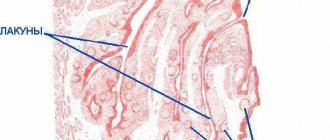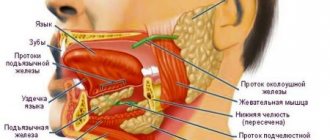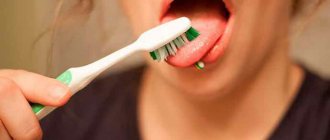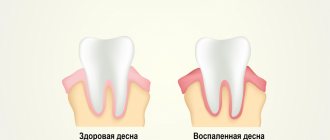This is a fairly common disease that can occur in both children and adults, but the former are more often affected by it. In any case, it is important to know how to quickly cure a sore throat in order to quickly alleviate the patient’s condition and to prevent the development of complications. Despite the prevalence of the disease and, it would seem, a lot of known methods of treating it, you should not neglect medical help. To understand the insidiousness of the disease, you should learn more about it - what it is, what types there are and what methods of elimination are used.
This is what you will learn about sore throat and its treatment by reading this article
- What is a sore throat?
- Types of sore throat, symptoms, treatment
- Catarrhal sore throat
- Symptoms
- Treatment
- Follicular tonsillitis
- Symptoms
- Treatment
- Lacunar tonsillitis
- Symptoms
- Treatment
- Fibrinous tonsillitis
- Symptoms
- Treatment
- Quinsy
- Symptoms
- Treatment
- Herpangina
- Symptoms
- Treatment
- Ulcerative membranous tonsillitis
- Symptoms
- Treatment
- Traditional medicine in the treatment of sore throat
- Treatment of sore throat with antibiotics
- Complications of sore throat
- When should you call an ambulance?
- Nutrition for sore throat
- Mistakes in the treatment of sore throat
What is a sore throat?
This is a disease of infectious origin, occurring in an acute form. Its causative agent is usually bacteria (most often the disease is caused by beta-hemolytic streptococcus, staphylococcus). But viruses and fungi can provoke the disease. How to quickly cure a sore throat depends on what kind of microorganisms it is caused by, because only those drugs that can act directly on them will be effective.
The infection affects the palatine tonsils, causing them to become inflamed, which is accompanied by the accumulation of pus, swelling, and difficulty breathing. In medicine, the disease is also known as acute tonsillitis. Considering that it is infectious, tonsillitis is contagious and is transmitted by airborne droplets, through household items, and food.
how to treat a sore throat
For reference. The tonsils are lymphatic tissue that is part of the pharyngeal ring. Thanks to them, peripheral immunity is formed, they protect the body from infections.
Back to Contents
Important!
A deadly disease called “diphtheria” at the initial stage can masquerade as a sore throat. Therefore, it is better to play it safe and take a throat swab, which will determine the presence of Loeffler’s bacillus (diphtheria bacillus). This must be done even if you are vaccinated against diphtheria - the vaccine does not provide 100% protection, although it significantly reduces the likelihood of developing a severe form of the disease. A smear helps not only to remove the diagnosis of diphtheria, but also to identify the causative agent of sore throat.
Types of sore throat, symptoms, treatment
Depending on the course of the disease, its symptoms, its varieties are as follows:
- Catarrhal;
- Follicular;
- Lacunarnaya;
- Fibrinous;
- Phlegmonous;
- Herpetic;
- Ulcerative-membranous.
General signs of the disease are:
- Pain in the throat, which is sharp and intensifies during conversation, when swallowing;
- Fever (depending on the type of illness and the severity of its course, it can reach 40 degrees);
- General weakness of the body, severe muscle weakness;
- Headache;
- Redness of the tonsils and mucous membranes of the throat;
- The appearance of white plaque on the tonsils, their enlargement.
In the first stages of the disease, it can be confused with the flu or a cold, although it is more severe. The main symptom that can be used to suspect a sore throat is severe pain in the throat, which makes it difficult to speak, eat, and breathe.
The most important thing in how to get rid of a sore throat quickly and effectively is an integrated approach. What must be included in the process?
- Bed rest. Without it, therapy may be ineffective, and this is fraught with complications;
- It is important to follow a certain diet;
- The patient needs to drink plenty of fluids, which will help fight the infection faster;
- Be sure to gargle using special preparations;
- Medicines with antihistamine and anti-inflammatory effects can be used. If the disease is of bacterial origin, then the use of antibiotics will be required. The choice of group of drugs depends on the causative agent of the disease.
In some cases, if there is a risk that the patient may suffocate and/or the infection spreads to neighboring organs, surgical intervention may be required.
Back to Contents
Catarrhal sore throat
This is a type of acute tonsillitis, which is one of the mildest forms of the disease. It is an inflammation of the mucous membrane of the throat and often develops against the background of reduced immunity of the patient. Considering that the body’s defenses usually decrease in the autumn-winter period, this disease also often attacks precisely during this season.
The catarrhal type of the disease is characterized by a high percentage of transmission, but patients tolerate it much faster and easier than other types of tonsillitis.
Symptoms
Signs of catarrhal tonsillitis usually appear quickly - the incubation period ranges from several hours to 2-3 days. Its symptoms are:
- Enlargement of the tonsils and their acquisition of a bright red color, severe swelling;
- The presence of a translucent film-like coating on the tonsils;
- Difficulty swallowing;
- Sore, dry throat;
- Increased body temperature. It is not always significant - the temperature can rise to 37.2, but it is possible that it will rise to 39 degrees. Often this symptom is accompanied by body aches and weakness.
Symptoms such as dizziness, nausea, vomiting (signs of intoxication) occur less frequently. If a patient has a white coating on his tongue, a doctor during a face-to-face examination can most likely assume that the causative agent of the disease is bacteria.
Treatment
Due to the high rate of disease transmission, the patient should be isolated. As for how to treat catarrhal tonsillitis, it is important to use a set of measures:
- Drink plenty of fluids;
- Due to the fact that it is painful for the patient to swallow, during treatment he should switch to pureed, liquid food;
- Bed rest is mandatory;
- To eliminate the inflammatory process and pain, sprays are prescribed (Hexoral, Orasept, Faringo-spray);
- In the absence of intoxication of the body, drugs of the sulfonamide group (Streptotsid, Septrin, Biseptol) are prescribed;
- If the temperature reaches 38 degrees or more, antipyretic medications are used (Paracetamol, Ibuprofen, Cefekon);
- The doctor may also prescribe medications with antiallergic effects (“Loratadine”, “Suprastin”, “Diazolin”);
- A good therapeutic effect is obtained by gargling, for which solutions with hydrogen peroxide, boric acid, and calendula infusion are used. The lacunae of the tonsils should be washed using an iodine solution.
how to cure a sore throat
You can cure a sore throat without antibiotics - the listed remedies are quite capable of dealing with it. Recovery can be achieved within a 6-7 day period. But if the bacterial origin of the disease is confirmed and the listed set of methods does not help, then the doctor prescribes antibiotics.
Follicular tonsillitis
This is a purulent type of the disease, characterized by a severe course. This type of inflammatory process is most often provoked by streptococci and staphylococci. Children and adolescents are most susceptible to the disease. Considering the nature and severity of the disease, how to treat purulent sore throat is a task whose solution should be entrusted to a doctor.
Back to Contents
Symptoms
The disease manifests itself acutely, rapidly, but not always with a sore throat, as is the case with many other types of tonsillitis. The first signs are similar to flu and colds - chills due to elevated temperature, muscle pain, headaches, body aches. Following these manifestations, the following symptoms of follicular tonsillitis begin to make themselves felt:
- Pain in the throat, which can radiate to the temple or ear when swallowing or talking;
- Enlarged lymph nodes, and in many patients they become so large that they feel them, and turning the head is accompanied by pain;
- A sign directly characteristic of follicular tonsillitis is the appearance of small purulent spots on the palatine tonsils, which are white or light yellow in color. On the affected areas they appear as bubbles;
- Due to the presence of pus, the patient develops an unpleasant taste in the mouth, as well as bad breath.
Treatment
It is necessary to exclude the patient’s physical activity and maximize the amount of fluid he consumes (tea, water). A set of measures used to quickly cure follicular tonsillitis includes:
- The insidiousness of the disease lies in the fact that it can provoke the development of a runny nose and the accumulation of purulent discharge in the nose. Therefore, in addition to antiseptic throat sprays (Iodinol, Ingalipt, Hexoral), you should also use nasopharynx cleansers (for example, Dolphin);
- Inhalation with eucalyptus helps eliminate the infection, but it is recommended to use them if the patient does not have a fever;
- It is not always possible to cure purulent (follicular) sore throat without antibiotics. The most effective in this case are representatives of the penicillin group (“Penicillin”, “Amoxicillin”);
- Furacilin solution removes purulent “sacs” well;
- If the patient is bothered by a high temperature, one cannot do without drugs that have an antipyretic effect (“Citramon”, “Paracetamol”, “Aspirin”);
- It is often necessary to use antihistamines.
Due to the fact that children often become patients with follicular tonsillitis, an important question for parents is how to treat a child’s sore throat at home. The listed methods contribute to this, and it is recommended to add to them the use of Faringosept and Doctor Mom lozenges, which help soften the tissues of the throat and eliminate purulent spots.
Lacunar tonsillitis
The palatine tonsils have many depressions called lacunae. These depressions with their branches extend into the lymphoid tissue. Lacunar tonsillitis affects lacunae and has an external resemblance to follicular tonsillitis. Both types can develop simultaneously, and for an inexperienced person it is almost impossible to visually determine the type of inflammation and distinguish one from the other.
Children and adolescents are most often affected by the disease, and in people over 50 years of age it is much less common.
Symptoms
The disease develops rapidly, and within the first day all its signs appear:
- High temperature, which can be 38-41 degrees. Without this symptom, the disease rarely occurs;
- The appearance of exudate on the surface of the mouths of lacunae. It appears as a coating in the form of small yellowish islands. This is a characteristic sign of the lacunar variety of the disease, which is similar to the main symptom of follicular tonsillitis;
- Bad breath, bad taste;
- Redness of the cheeks with noticeable pallor in the area of the nasolabial triangle (another sign accompanying lacunar tonsillitis itself);
- Sore throat when swallowing or talking.
The remaining symptoms of the disease are nonspecific and include headache, muscle pain, general malaise, pain in the jaw area, and loss of appetite.
Treatment
As with other types of sore throat, bed rest and plenty of warm fluids are required. If lacunar tonsillitis strikes, how to quickly cure it will depend on what measures are taken for this. And the following are effective:
- Antibacterial rinses (Biclotymol, Miramistin, Chlorhexidine) are used as local therapy;
- Regardless of whether the task is to cure lacunar tonsillitis in an adult or cure lacunar tonsillitis in a child, it is necessary to identify its causative agent. In accordance with this, the main method of therapy is selected. If it has a viral etiology, antiviral medications are used (Kipferon, Viferon). Antibiotics of the penicillin group (Amoxiclav, Amoxicillin, Phenoxymethylpenicillin) are effective in the fight against bacterial lacunar tonsillitis. If the disease is caused by fungi, the use of Lugol's solution, Fluconazole is indicated;
- If the patient has an allergic reaction to the medications used, you need to resort to antihistamines (Cefditoren, Cefixime);
- If treatment with the listed antiviral, antifungal, and antibacterial drugs is impossible, alternative antibacterial agents (Azithromycin, Clindamycin, Josamycin) are prescribed.
Back to Contents
Prevention at home for adults and children: what to do to avoid getting infected or getting a sore throat
Prevention is the most effective method of combating any disease. It is easier to prevent infection from entering the body than to expel it from there. In order to minimize the risk of getting a sore throat, follow some rules.
- Proper nutrition . The diet should be enriched with vitamins. Particular attention should be paid to groups B and C. Also, nutrition should be correct in terms of balance. It is advisable to receive daily norms of all elements necessary for the body. Eating late, overeating or undereating will also weaken the body.
- Sports activities . This point will be especially relevant for older people, office workers and workers in similar quiet professions. Exercise will strengthen the heart and blood vessels, improve blood flow, which will more effectively remove waste and toxins from the body, preventing them from reducing immunity. It’s worth accepting this fact and starting doing exercises so that you don’t take pills again later.
- Visiting a sanatorium, relaxing at resorts . Such a vacation will relieve the body not so much physically, but psychologically. Clean air, water, absence of city bustle - people accustomed to all this do not notice the negative consequences, but once you try, it will become clear how exhausted the body is.
- Rejection of bad habits . Particular attention is paid to smoking. It affects the throat - the main target of sore throat.
- Prevention with lemon and ginger . Regular consumption of these products 2 times a week will help strengthen your overall immunity.
- Elimination of chronic diseases of the nasopharynx . This includes rhinitis and sinusitis. Often, due attention is not paid to the need to treat such diseases; they do not particularly manifest themselves. But because of them, the immune system is greatly weakened, because it is inflammation that becomes the source of infection.
There is a widespread belief online that a protein-free diet will also help strengthen the immune system. This absolutely cannot be believed. Protein is a building material for the body. It nourishes muscles, ligaments, tendons, and participates in the formation and renewal of tissues. Such a restriction will only weaken the body, and in especially severe cases can lead to diseases other than sore throat.
Fibrinous tonsillitis
Often this type of disease develops as a consequence of follicular or lacunar tonsillitis. It is difficult and the patient’s condition worsens significantly, especially if it is not treated in a timely manner.
Symptoms
Most of the signs of the disease are typical for sore throat - sore throat, muscle pain, inflammation of the lymph nodes, fever, fatigue. Characteristic symptoms for fibrinous tonsillitis are:
- The appearance of a gray film-like coating on the throat and tonsils. This kind of plaque occurs with diphtheria. In the absence of complications, it is easily separated without bleeding;
- If candidiasis or mononucleosis joins the disease (which often happens), it acquires a yellowish tint. In this case, there may be problems with removing plaque;
- Severe course of the disease, the appearance of complications may be accompanied by symptoms such as suffocation, severe swelling of the nasopharynx, disturbances in heart rhythms, and pain in the eyes.
Treatment
It will be difficult to get rid of the disease without the intervention of a doctor, and there is no need to take risks. How to quickly cure a sore throat in an adult and a child if it has acquired a fibrinous form?
- Be sure to maintain drinking and bed rest - there should be plenty of rest and fluids;
- In addition to traditional antiseptic rinsing solutions (iodine-containing medications, Furacilin, Chlorhexidine), you can use herbal decoctions based on sage and chamomile;
- To get rid of the disease, it is important to normalize blood circulation in the throat area, which is done with the help of compresses. A towel, previously soaked in cool water and wrung out, should be wrapped around the throat, carefully insulating it on top with a scarf or blanket. It is recommended to keep the compress for about an hour, and carry out the procedure three times a day;
- Severe disease will require the use of sulfonamides and penicillins;
- During treatment, it is advisable to consume as many foods and drinks as possible containing vitamin C - it helps destroy pathogenic microorganisms.
Prevention and precautions when communicating with a patient
- Clothes must be worn appropriately for the weather conditions to completely prevent hypothermia.
- Regularly scheduled visits to the dentist will prevent large-scale development of caries and neutralize small foci of infection.
- Quitting nicotine, drug addiction and alcohol will restore the body's defenses.
- Sports activities will strengthen the immune system.
- Having proper rest and healthy food significantly improves metabolic processes.
- During seasonal epidemics, it is advisable to avoid attending public events.
When communicating with a patient with purulent tonsillitis, you should wear a cotton-gauze bandage, and also practice preventive gargling, using nasal ointments.
If therapy is carried out at home, it is important to clean the room every day using disinfectant solutions and periodically ventilate the room
Prevention of sore throat in pictures
Quinsy
In medicine, the disease is also known as paratonsilitis or paratonsillar abscess. It usually develops as a consequence of other types of tonsillitis - a couple of days after the end of the disease. The disease affects the peri-almond tissue and is characterized by a severe course.
Symptoms
The disease begins with the same manifestations as other forms of tonsillitis. But the pain in the throat is acute and pronounced. Other characteristic symptoms of the disease:
- Severe redness of the ocomandal tissues, their swelling;
- The tonsil may be displaced, protruding above the level of the niche;
- Enlarged lymph nodes in the neck;
- Increased salivation;
- A pronounced nasal tone may appear;
- It is often impossible or very difficult to open your mouth completely.
Treatment
When the disease occurs, pus accumulates, often on one side, above the upper part of the tonsil. Antibiotics can be used for therapeutic purposes, and analgesics, antihistamines, and antipyretics can be used to alleviate the patient’s condition. But the main method of treatment, if phlegmon (accumulation of purulent discharge) develops, is the surgical method.
Causes and routes of infection for sore throat
The inflammatory process develops under the influence of pathogenic microflora. The causative agent of the pathology is considered to be:
- staphylococcal;
- streptococcal;
- energy virus;
- pneumococcal;
- diplococcal infection.
The main ways of contracting tonsillitis are:
- airborne - when sneezing, coughing or talking to a carrier;
- hematogenous - microflora moves along with the blood from foci of inflammation located in other areas;
- enteral - pathogens enter with food (uncooked milk), through unwashed hands;
- endogenous – formed against the background of caries, gastroenteritis, purulent sinusitis;
- traumatic – formed during operations on the ENT organs.
Sore throat occurs at any age, the risk of its occurrence is associated with an inadequate diet, without a sufficient amount of nutrients, overwork, and severe hypothermia. The pronounced activity of pathogens indicates dysfunction of the immune system.
Herpangina
The causative agents of this disease are usually enteroviruses. It can also be a complication of the flu. The external similarity of the ulcers covering the tonsils was the reason for this name of the disease. Children aged 3-10 years are most susceptible to the disease.
Symptoms
The first manifestation of herpetic tonsillitis is general weakness and fever. The following signs make themselves felt:
- Pain in the throat;
- Upon examination, the patient reveals a rash on the tonsils in the form of blisters with grayish contents. The tissues of the pharynx themselves become red;
- Difficulty swallowing;
- Pain in the area of the cervical lymph nodes;
- Children under 4 years of age do not always experience a sore throat, but the child may lose appetite due to colic and nausea.
Treatment
The course of the disease is usually not severe, but this does not mean that it can not be treated. Treatment of sore throat at home can be carried out using the following measures:
- Drink plenty of fluids, bed rest;
- The use of antipyretic medications (for example, Ibuprofen, Nimesulide);
- The use of antihistamines (Claritin, Loratadine, Zyrtec);
- Gargling with antiseptic agents (“Cameton”, “Yox”, “Inhalipt”);
- The use of antiviral drugs (Viferon, Tsitovir, Cycloferon).
Back to Contents
Surgery
Contrary to popular belief, tonsil removal (tonsillectomy) is not a surgical treatment for tonsillitis.
Rather, it is a forced measure to eliminate the consequences of a sore throat, when other methods fail to eliminate a strong focus of infection in the tonsils for a long time. The main indication for tonsillectomy is relapse of phlegmonous tonsillitis. It is this type of tonsillitis that implies the only case when conservative therapy has to be resorted to surgical methods. The point is a purulent abscess that matures in the thickness of the tonsil parenchyma. Content may be difficult to view
There are three options for surgical intervention:
- Puncture of the abscess in the area of greatest protrusion and subsequent pumping out of pus with a syringe.
- Incision of the abscess in a similar place and spreading the edges of the wound with a forceps so that the purulent masses can flow out.
- Blunt opening of a mature abscess with a forceps without a puncture or incision (suitable when pus is clearly visualized).
Naturally, in all cases, local anesthesia with a Bonen mixture (cocaine, menthol, phenol) is required - lubricating the surface of the tonsils. Plus a novocaine injection in the area of the jaw muscles (especially important if trismus occurs). After the initial opening, the next day it is necessary to re-spread the edges of the wound and rinse off any remaining pus. If the exudate is not completely cleared, then the risk of recurrent abscess is high.
Ulcerative membranous tonsillitis
Inflammation occurs due to the interaction of an oral spirochete and a spindle-shaped rod. The risk group is people with reduced immunity.
Symptoms
Typically, the disease causes a slight increase in temperature, a sore throat, and swollen lymph nodes. There are also characteristic signs of ulcerative-membranous tonsillitis - the appearance of ulcers, a dirty greenish coating, and the presence of a putrid odor. As a rule, damage to the tonsil tissue is unilateral.
Treatment
Fighting the disease often requires hospitalization of the patient in the infectious diseases department. How to quickly cure a sore throat for an adult in this case?
- An effective method is to treat ulcers with solutions such as boric acid, manganese, rivanol, and methylene blue. Procedures should be carried out 2-3 times/day;
- If the disease does not subside for a long time and is severe, antibiotics are included in the therapy (Novarsenol, Benzylpenicillin, Miarsenol);
- Vitamin therapy is used as an additional measure (it is important to saturate the body with vitamins C, P, B).
Ulcers with fever
Plaque on the tonsils, accompanied by signs of intoxication, indicates a viral or bacterial infection. Ulcers in the throat with fever most often occur with sore throat, as well as scarlet fever, the causative agents of which are streptococcus, staphylococcus, and klebsiella.
The disease begins with an increase in temperature, the appearance of painful sensations in the oropharynx during swallowing and in the normal state. In the catarrhal form of tonsillitis, the tonsils are enlarged, loosened, and covered with transparent mucus. The tongue is covered with a white coating, and painful sensations are observed when swallowing. Treatment of angina must be comprehensive. It includes the use of antibacterial drugs, symptomatic therapy, as well as means for local treatment of the throat.
Abscesses with fever can also occur with infectious mononucleosis and adenoviral infection. Both of these diseases are very acute. Initially, the temperature rises, and then other symptoms appear.
Diseases such as herpetic sore throat and aphthous stomatitis can provoke the formation of ulcers in the throat. Sore throat occurs when the body is infected with enteroviruses and is similar in symptoms to the course of herpes. With stomatitis, whitish ulcers form that completely cover the entire pharynx and oral mucosa.
Traditional medicine in the treatment of sore throat
How to treat a sore throat at home to achieve quick results and preferably without antibiotics, many people are interested in, and especially parents of children who are afraid to treat them with chemicals.
Treatment of sore throat at home: the most popular remedies
- Inhalations with boiled potatoes. The vegetable must be boiled, left in the pan, and allowed to cool slightly so that the patient does not get burned. Then he needs to wrap himself in a towel, bend over the pan, and breathe for 10-15 minutes. The procedure should be repeated daily;
- Beetroot broth. The vegetable needs to be boiled until it becomes soft, and then cool the broth; it should be warm, but not hot. You need to gargle with the product several times a day;
- Herbal infusions. Such healing plants as chamomile, sage, oak bark could not be ignored, because they can even help in how to cure a purulent sore throat quickly at home. This is due to their antiseptic properties and ability to relieve pain. Brew 1 tbsp. l. any of the plants in 1 glass of water, let it brew until it cools, strain. You need to gargle with the product several times a day;
- Marigold. Brew 10 flowers in 1 tbsp. boiling water, let the infusion cool under the lid. Gargle with warm, expressed liquid once a day;
- Cognac and cumin. Are you looking for how to quickly cure a sore throat in 1 day? They say this is the very means by which this can be done. You need to grind 80 g of cumin into flour, pour a glass of water into it, and boil for a quarter of an hour. Strain the resulting mass, add a quarter glass of water to it. Let the mixture boil and immediately remove from heat. Add 1 tsp to the product. cognac, take 1 tsp. at intervals of half an hour for 4 hours;
- Onion peel. This folk recipe, used at home, helps against many diseases, including tonsillitis. 3 tsp. The husks need to be boiled for several minutes in ½ liter of water. Let the broth brew for 2-3 hours, then decant. Gargle with the resulting liquid at least 5 times a day.
When it comes to how to quickly cure a sore throat, folk remedies show high effectiveness, but if the disease is severe, they may not be enough.
Local therapies
How to quickly eliminate the signs of tonsillitis is a question that worries many patients. In order to quickly restore good condition with tonsillitis, it is imperative to first cure the throat using local remedies. To eliminate pathogens and reduce pain, Lugol will come to the rescue. This remedy is a ready-made antiseptic drug that has a detrimental effect on staphylococci.
Since Lugol contains glycerol, it helps soften the pharyngeal mucosa. With the help of this remedy we treat sore throat quickly, even if it is purulent.
To achieve the best effect of therapy, this drug should be sprayed 2-5 times a day and after a while you will feel significant relief.
- Sore throat - how to quickly cure a child’s sore throat
Complications of sore throat
Primary types of the disease are usually not severe, but if they are not treated, complications are possible in the form of their transition to more severe forms (for example, follicular, phlegmonous tonsillitis). If these diseases are not treated, infection may spread and pus may enter other organs. Private local complications of tonsillitis include:
- Otitis;
- Edema of the larynx;
- Inflammation in the lymph nodes;
- Bronchitis, tracheitis, pneumonia.
Systemic complications are also possible:
- Heart diseases;
- Kidney diseases;
- Joint ailments.
Back to Contents
Possible complications of a purulent process in the throat
Treating purulent tonsillitis at home is allowed only after detailed consultation with specialists, since self-medication is considered dangerous for any form of tonsillitis, and especially for complicated purulent tonsillitis. The pathological process can provoke serious complications in the patient, leading to severe chronic disorders in the body and, in some cases, to fatal consequences.
- The migration of purulent formations into the deep layers of the muscle tissue of the throat and pharynx provokes the occurrence and progression of tissue abscess.
- Untimely and poor-quality treatment of purulent tonsillitis can provoke the penetration of purulent infection into the meninges. Against the background of rupture of a purulent focus, the patient may experience progression of a purulent form of meningitis.
- Self-opening of purulent foci provokes the penetration of pus into the auditory tube, against this background purulent inflammation of the eardrum, ears and inner ear develops.
- The spread of pyogenic microbes throughout the body provokes a general blood infection in the patient with a possible fatal outcome.
- The purulent form of tonsillitis often provokes the development of secondary pathology of internal organs: heart, kidneys, joints.
These complex pathological processes in the body are provoked by streptococcal bacteria against the background of a late response in the treatment of tonsillitis.
Mistakes in the treatment of sore throat
Most often they are:
- Gargling for children under 4 years of age. They do not know how to retain liquid in the throat, so this method of treatment should be avoided, replacing it, for example, with rubbing, taking syrups;
- How to quickly cure a sore throat without antibiotics is an interesting question, and it is possible, but not always. You can do without them if the disease is not severe, but in some cases, avoiding them until the last minute can lead to serious complications;
- If antibiotics cannot be avoided, be sure to complete their course to the end, even if the patient begins to feel better. Otherwise, the therapy will be ineffective and complications may occur;
- How to cure a sore throat in one day? Unfortunately, this is not always possible. Most often, this takes at least several days.
Relief of sore throat due to sore throat
And the most important mistake is self-medication. Yes, if you have a sore throat, how to quickly cure your throat, doing it at home, becomes a pressing topic. But you need to remember that no matter what, in your opinion, proven remedies you use, without a doctor’s recommendations you can go down the wrong path, provoking complications of the disease. In addition, no medications, and especially antibiotics, can be prescribed independently, just as their doses and duration of treatment cannot be determined.
Prevention
The following will help reduce the risk of disease:
- compliance with personal hygiene rules, in particular regular hand washing2;
- hardening: air baths, rubdowns and showers with gradually decreasing water temperature, gargling with cold water2;
- morning exercises and physical education classes2;
- sanitation of the oral cavity: carious teeth, sore gums, chronic rhinitis, sinusitis, adenoids;
- sanitation of ENT foci of infection - therapy of rhinitis, sinusitis, solution to the problem of nasal congestion, which forces you to breathe through the mouth and reduces the protective functions of the mucous membrane of the oropharynx2.
The information in this article is for reference only and does not replace professional advice from a doctor. To make a diagnosis and prescribe treatment, consult a qualified specialist.
Literature
- N.L. Kunelskaya, A.B. Turovsky. Sore throats: diagnosis and treatment // “Breast cancer”. - 2010. - No. 7, p. 438.
- V.S. Dergachev. Angina. Clinic, diagnosis and treatment algorithm. Choice of local antibacterial therapy // “Breast Cancer”. – 2007. – No. 18, p. 1350.
- G. Z. Piskunov, I. B. Angotoeva. Acute tonsillopharyngitis // Attending physician. – 2007. – No. 2.
- P.A. Kochetkov, V.M. Svistushkin. Acute streptococcal tonsillitis - modern principles of therapy // “Breast Cancer”. – 2014. – No. 26, p. 1891.
- Polyakova T.S., Polyakova E.P. Chronic tonsillitis: diagnosis, treatment, prevention // “Breast cancer”. – 2004. – No. 2, p. 65.
- Instructions for use of the drugs HEXORAL® SOLUTION and HEXORAL® AEROSOL.
- Instructions for use of HEXORAL® TABS and TABS CLASSIC.
- Instructions for use of HEXORAL® TABS EXTRA.
Inhalations
For sore throat, inhalation is an effective method of treating a sore throat - during inhalation, tissues are heated, medicinal extracts go directly to the site of the disease. Home inhalations are often carried out on the basis of herbal decoctions; below are several sample recipes.
- Prepare a decoction of dry St. John's wort and chamomile - pour 3 tablespoons of herbs into a liter of water, bring to a boil, cool - you can get a burn from the steam. To enhance the effect, add a few drops of any coniferous essential oils. Inhalation is carried out as in the previous recipe - for 20 minutes.
- Take 2 tablespoons of crushed dry chamomile, mint, sage, pour in a liter of warm boiled water. Bring the mixture to a boil over low heat, then remove from heat and allow to cool slightly. The patient bends over a vessel with a decoction, his head is covered with a towel. You need to breathe through your mouth - this is how steam with healing extracts reaches the affected areas.
It is important to know that inhalations are contraindicated at elevated temperatures; they are usually carried out at the last stage of treatment, as an additional procedure to restore the mucous membrane of the throat.
Compresses
Moist compresses for warming the chest and neck are very effective in treating sore throat. They help stop the development of the inflammatory process, reduce sore throat and increase blood circulation. An important condition for using compresses is normal body temperature (36.6?). At a late stage of disease progression, when ulcers appear on the tonsils, warm compresses cannot be used.
The compress can be applied to the throat, excluding the thyroid gland area. A cloth soaked in a specially prepared solution is applied to the skin. Then it is covered with plastic film. For insulation, everything is covered with a layer of flannel, and then tied with a warm scarf.
There are many recipes for medicinal and warming compresses that can be used to treat sore throat.
- Cabbage leaf with honey also warms well and stops the inflammatory process. In order for the cabbage leaf to become a little softer, you need to pour boiling water over it and leave for a couple of minutes. after this, the warm sheet should be blotted with water, greased with honey and applied to the neck with this side. Cover the top with film and tie it with a scarf.
- A compress from boiled potatoes is prepared as follows: wash the potatoes and boil them with their skins on, then knead them, add a few drops of an alcohol solution of iodine and a spoonful of any vegetable oil. The resulting mass is placed in a gauze bag. When the temperature of the potato becomes tolerable for the skin, it is applied to the throat and wrapped around the neck. This compress can be left on even overnight.
- An alcohol compress is easy to prepare. To do this, you need to take 70% medical alcohol and dilute it with cold boiled water in a 1:1 ratio. To achieve a greater effect, take not simple alcohol, but an alcohol tincture with herbs. You can drop a few drops of some essential oil there, for example, eucalyptus or lavender. This compress should be used with caution by those with sensitive skin to avoid getting burned.
- A compress of raw potatoes with vinegar is prepared as follows: you need to grate 2-3 medium-sized tubers on a fine grater, add 1 tablespoon of 6% vinegar, place it in a thick fabric bag and apply it to your throat. This remedy perfectly relieves inflammation.
Children can apply compresses 1-2 times a day, and it is better to do this before bed. At the same time, it is desirable that your feet are also warm. Adults can apply warm compresses to a sore throat for 3-4 hours, taking two-hour breaks in between.
conclusions
- Sore throat (tonsillitis of any type: streptococcal, bacterial, lacunar) may not manifest itself immediately, which increases the risk of complications.
- It can be treated at home, but only not in severe forms and under the supervision of an otolaryngologist.
- A high temperature with inflamed tonsils (the throat may begin to hurt, become swollen, painful to swallow, a lump or plug in the throat) is always present with tonsillitis.
- In order to prevent the disease from developing, it is worth resorting to first aid measures, even if there are only suspicions.
- Treatment in pregnant women differs only in less severe antibiotics.
- If you do not start treatment on time, you can get complications, the throat will not go away for a long time and nothing will help.
- The best way to prevent disease is prevention.










